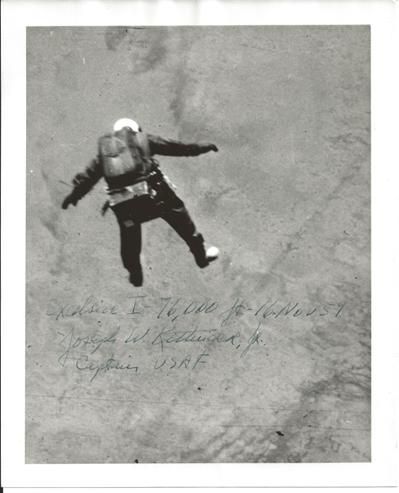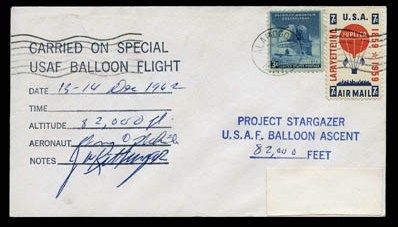Space Autograph of the Week Topic 8: Joe KittingerColonel Joseph William Kittinger II is a former command pilot, career military officer and retired Colonel in the United States Air Force. He is famous for his participation in Project Manhigh and Project Excelsior, in 1960 setting the record longest skydive, from a height greater than 19 miles which would stand for 52 years. In addition to the stratospheric balloon flights he was also the first man to make a solo crossing of the Atlantic Ocean in a gas balloon.
Serving as a fighter pilot during the Vietnam War, he achieved an aerial kill of a North Vietnamese jet fighter and was later shot down himself, spending 11 months as a prisoner of war in a North Vietnamese prison. He just participated as “Capcom 1” in the Red Bull Stratos project as capsule communicator and mentor, directing Felix Baumgartner on his record-breaking 24 mile skydive from Earth's stratosphere.
Kittinger entered the U.S. Air Force in March 1949. In 1954 Kittinger was transferred to Holloman AFB, New Mexico and the Air Force Missile Development Center (AFMDC). A pioneer in aerospace medicine Colonel John Stapp recommended him for space-related aviation research work.

The project started in December 1955 to study the effects of cosmic rays on humans. Three balloon flights to the stratosphere were made during the program:
- Manhigh I to 29,500 m (96,784 feet), by Kittinger on June 2, 1957 setting an interim balloon altitude record of 96,760 feet, for which he was awarded his first Distinguished Flying Cross.
- Manhigh II to 30,900 m (101,516 feet), by Major David G. Simons on August 19–20, 1957 for a 32-hour flight,
- Manhigh III to 29,900 m (98,097 feet), by Lieutenant Clifton M. McClure on October 8, 1958.
Captain Kittinger was next assigned to the Aerospace Medical Research Laboratories at Wright-Patterson AFB in Dayton, Ohio. For Project Excelsior where he made a series of three extreme altitude parachute jumps from an open gondola carried aloft by large helium balloons. These jumps were made in a "rocking-chair" position, descending on his back, rather than in the usual face-down position familiar to skydivers. 
Kittinger's first high-altitude jump, from about 76,400 feet on November 16, 1959, was a near-disaster when an equipment malfunction caused him to lose consciousness. The automatic parachute opener in his equipment saved his life. He went into a flat spin at a rotational velocity of about 120 rpm. The g-forces at his extremities have been calculated to be over 22 times the force of gravity, setting another record.
Excelsior II: On December 11, 1959, he jumped again from about 74,700 feet. For that leap, Kittinger was awarded the A. Leo Stevens Parachute Medal.
Kittinger's then record-breaking skydive from Excelsior III: On August 16, 1960, he made the final jump, from the Excelsior III, at 102,800 feet. Towing a small drogue parachute for initial stabilization, he fell for 4 minutes and 36 seconds, reaching a maximum speed of 614 miles per hour before opening his parachute at 18,000 feet. Pressurization for his right glove malfunctioned during the ascent, and his right hand swelled to twice its normal size.Ignoring the pain, he rode the balloon up to 102,800 feet before stepping off.
Kittinger set historical numbers for highest balloon ascent, highest parachute jump, longest drogue-fall (four minutes), and fastest speed by a human being through the atmosphere. These were the USAF records, but were not submitted for aerospace world records to the Fédération Aéronautique Internationale (FAI).

Back at Holloman Air Force Base, Kittinger took part in Project Stargazer on December 13–14, 1963. He and the astronomer William C. White took an open-gondola helium balloon packed with scientific equipment to an altitude of about 82,200 feet (25,100 m), where they spent over 18 hours performing astronomical observations.
Kittinger later served three combat tours of duty during the Vietnam War, flying a total of 483 missions and credited with shooting down a North Vietnamese MiG-21.
Kittinger was shot down on May 11, 1972, just before the end of his third tour of duty. While flying an F-4D, USAF Serial No. 66-0230, with his Weapons Systems Officer, 1st Lieutenant William J. Reich, Lieutenant Colonel Kittinger was leading a flight of Phantoms approximately five miles northwest of Thai Nguyen, North Vietnam, when they were engaged by a flight of MiG-21 fighter planes. Kittinger and his wingman were chasing a MiG-21 when Kittinger's Phantom II was hit by an air-to-air missile that damaged the fighter's starboard wing and set the airplane on fire. Kittinger and Reich ejected a few miles from Thai Nguyen and were soon captured and taken to the city of Hanoi.
Kittinger and Reich spent 11 months as prisoners of war (POWs) in the "Hanoi Hilton" prison. Kittinger was put through "rope torture" soon after his arrival at the POW compound. Kittinger and Reich were returned to American hands on March 28, 1973, and they continued their Air Force careers, with Kittinger promoted to full colonel.

Kittinger retired from the air force in 1978. Still interested in ballooning, he set a gas balloon world distance record at the time for the AA-06 size class of 3,221.23 km in 1983. He then completed the first solo Atlantic crossing in the 106,000 cubic foot "Balloon of Peace" from September 14 to September 18, 1984, it is the longest gas balloon distance flight in AA-10 size category. He participated in the Gordon Bennett Cup in ballooning in 1989 and 1994.
As shown above Kittinger has flown covers on many of his flights (both stratospheric and trans-Atlantic) and autographed many photos as well.

















